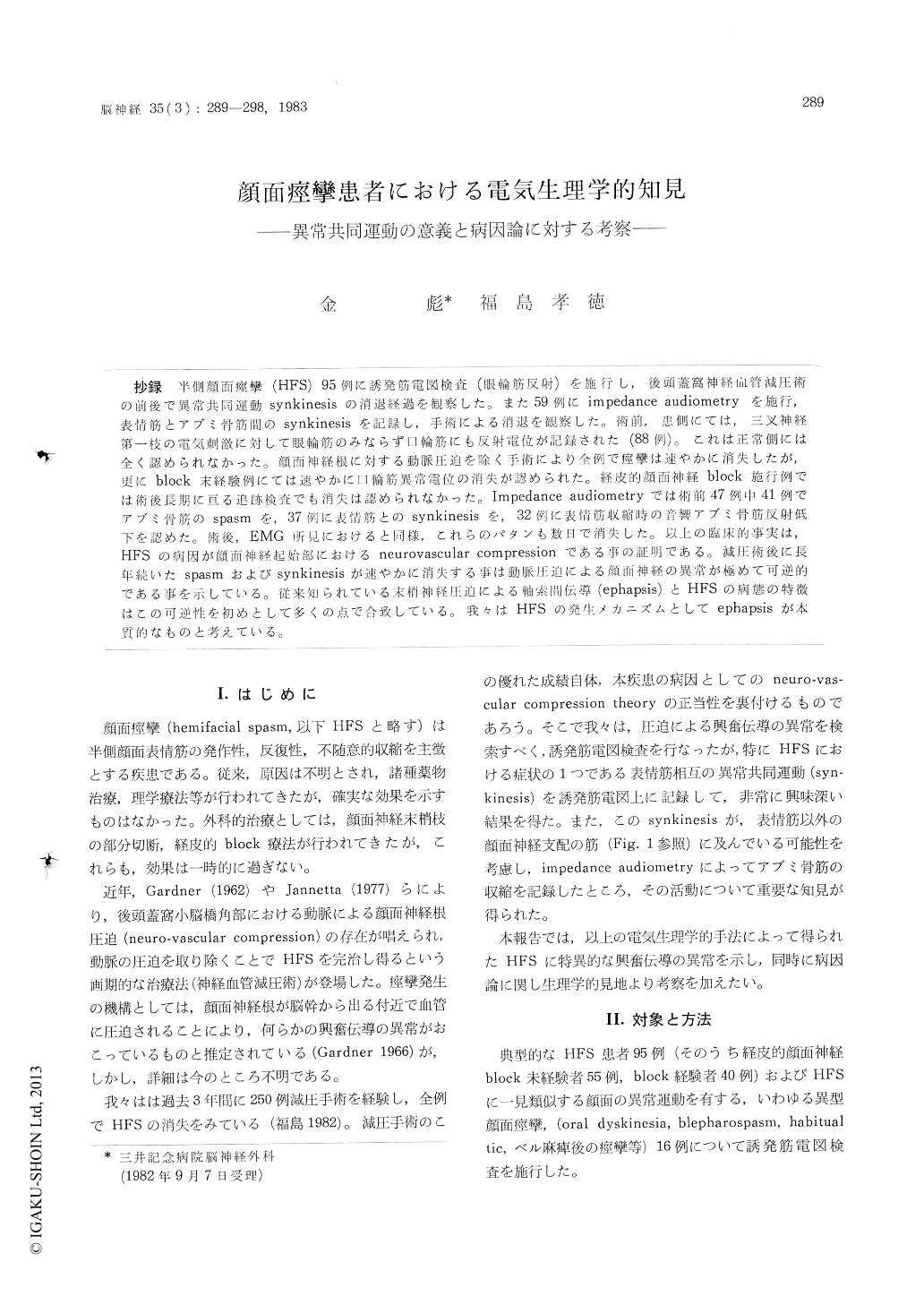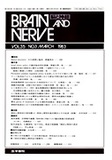Japanese
English
- 有料閲覧
- Abstract 文献概要
- 1ページ目 Look Inside
抄録 半側顔面痙攣(HFS)95例に誘発筋電図検査(眼輸筋反射)を施行し,後頭蓋窩神経血管減圧術の前後で異常共同運動synkinesisの消退経過を観察した。また59例にimpedance audiometry を施行,表情筋とアブミ骨筋間のsynkinesisを記録し,手術による消退を観察した。術前,患側にては,三叉神経第一枝の電気刺激に対して眼輪筋のみならず口輪筋にも反射電位が記録された(88例)。 これは正常側には全く認められなかった。顔面神経根に対する動脈圧迫を除く手術により全例で痙攣は速やかに消失したが,更にblock末経験例にては速やかに口輪筋異常電位の消失が認められた。経皮的顔面神経block方施行例では術後長期に亘る追跡検査でも消失は認められなかった。Impedance audiometryでは術前47例中41例でアブミ骨筋のspasmを,37例に表表情筋とのsynkinesisを,32例に表情筋収縮時の音響アブミ骨筋反射低下を認めた。術後,EMG所見におけると同様,これらのパタンも数日で消失した。以上の臨床的事実は,HFSの病因が顔面神経起始部におけるneurovascular compressionである事の証明である。減圧術後に長年続いたspasmおよびsynkinesisが速やかに消失する事は動脈圧迫による顔面神経の異常が極めて可逆的である事を示している。従来知られている末梢神経圧迫による軸索間伝導(ephapsis)とHFSの病態の特徴はこの可逆性を初めとして多くの点で合致している。我々はHFSの発生メカニズムとしてephapsisが本質的なものと考えている。
In 95 patients with classical hemifacial spasm (HFS), electromyographic investigation and/or im-pedance audiometry were performed to demon-strate abnormal synkinesis and its disappearance following posterior fossa microvascular decomp-ression.
In recordings of evoked EMG, electrical stimuli given to the supraorbital nerve of the affected side elicited abnormal reflex potentials in the ipsi-lateral orbicularis oris, in addition to the ordinary blink reflex potentials in the orbicularis oculi. Preoperatively, these abnormal synkinetic poten-tials were recorded in 88 cases out of 95 HFS patients. The synkinetic potentials were never observed in the unaffected contralateral side except for one case who had undergone prior cosmetic facial surgery. After decompression surgery, the abnormal synkinetic potential disappeared comple-tely in 31 cases who had no previous peripheral block prodedure. In 17 of them, synkinet is poten-tial disappeared within ten days after surgery, and only in one case the synkinetic potential per-sisted over one month after surgery. On the cont-rary, in the other 35 cases who had undergone peripheral block prior to surgery, synkinetic potential was persistently recorded even after ei-ght months postop.
Impedance audiometry disclosed spasm and syn-kinesis of the stapedius of the affected side. Middle ear compliance changed synchronously with voluntary contraction or spastic contraction of the affected facial muscles. Tonic contraction of the facial muscles caused sustained decrease in the compliance. During this sustained decreaseof compliance, acoustic stimuli (105 dB 1 kHz) was given to the contralateral ear to elicit acoustic stapedial reflex (SR). Reduction of the amplitude of the stapedial reflex (SR reduction) was observed in the affected side. This SR reduction is particu-larly important because the amplitude of SR is not affected if the apparent change in compliance is due to some artefact.
The preoperative recordings of 47 I-iFS patie-nts disclosed stapedial spasm in 41 cases (87%), stapedial synkinesis in 37 cases (78%) and SR re-duction in 32 cases (68%). These abnormal pat-terns were never observed in the contralateral normal side. After surgery, these abnormal pat-terns disappeared. Postoperative recordings were performed in 32 cases between seven and 14 days after surgery, and showed the presence of resi-dual abnormal stapedial activity (stapedial spasm or stapedial synkinesis or SR reduction) only in 6 cases.
The immediate disappearance of hemnifacial spa-sm as well as the synkinetic activities following microvascular decompression demonstrated that the abnormal conduction process of the compressed facial nerve is totally reversible. On the other hand, synkinesis due to regeneration-misdirection process following peripheral facial nerve block was irreversible. The physiological reversibility of the function of the compressed facial nerve strongly suggests that facial spasm is caused by the abnormal firing at the compressed site where ephaptic conduction is taking place.

Copyright © 1983, Igaku-Shoin Ltd. All rights reserved.


